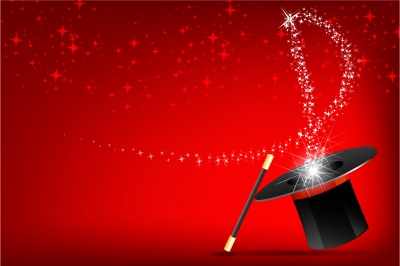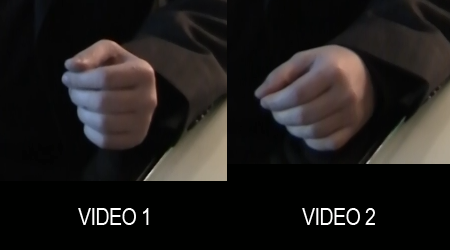Editor’s Note: Dr. Steve Bedwell is a medical doctor who, prior to becoming a motivational speaker, taught medicine at the world famous Royal London Hospital Medical School and conducted scientific research in Europe, Australia and the US. In addition—and somewhat bizarrely—he’s also an international-award winning magician who has lectured to other magicians in over twenty countries. Steve has also been honored several times with highly-coveted awards for his original conjuring methods which fool, not only muggles, but well posted magicians. And now, over to Steve…
In 1969, the same year that man walked on the moon, a book was published called The Magic of John Ramsey. Written by Andrew Galloway, it describes the magical methods of his mentor. On the first page of chapter one, the author quotes Ramsey: “If you want somebody to look at something, look at it yourself,” and “If you want somebody to look at you, look at them.”
Forty years later three psychologists—Gustav Kuhn, Benjamin W. Tatler and Geoff G. Cole—wrote a scientific paper called: You look where I look! Effect of gaze cues on overt and covert attention in misdirection. After tracking and analyzing the eye movements of thirty-two experimental subjects watching a magic trick they concluded: “…the magician’s gaze direction plays an important role in directing peoples’ attention.”
The authors felt their conclusion was sufficiently shocking to warrant an exclamation mark: “You Look Where I Look!” After all, it only took forty years, high tech equipment and custom software to come to the same conclusions that John Ramsey made using a handful of coins. While psychological and neuroscientific investigation of magic tricks may produce some useful observations, given this track record, it’s easy to see why the magic community isn’t exactly holding its collective breath.
Rebuttal
In a gratifyingly detailed rebuttal to a recent article I wrote entitled: When Harvard Meets Hogwarts, What Can Scientists Learn From Magicians? Tony Barnhart—a doctoral candidate in the Cognition, Action & Perception program at Arizona State University and a semi-professional magician—challenged my conclusions: here. This article is part of my rebuttal of his rebuttal of my original article. Confused? You will be!
First, let’s highlight the point on which Tony and I see eye-to-eye. He states that: “Magic remains a rich and largely untapped source of insight into perception and cognition.” I wholeheartedly agree. I’m in no way “resistant to psychology’s interest in [magical] methods.” In fact, I’m hugely interested in the intersection of magic and science. I pre-ordered a recent book (Sleight of Mind) that shone a neuroscientific spotlight on the principles of magic, read it the day it was published and paid a visit to the authors’ lab.
[showmyads]Here’s where Tony and I disagree: I believe that effectively studying a magician’s methods requires insights that extend way, way beyond (most) neuroscientist’s or psychologist’s areas of expertise. (It’s important to note that there are a handful of notable exceptions, scientists like Richard Wiseman and Peter Lamont who have actively studied magic for several decades—longer, in fact, than their academic careers.) For mind scientists in general to have any hope of studying magical methods they need a far deeper understanding of the principles involved. To date, the research into magic tricks has provided little insight, not because the project is inherently flawed but, rather, because the studies are riddled with unrecognized confounding factors.
Reductionism
In my original article I argued that: “…much of the work that has been published on the neuroscience of magic has involved honing in on one marginal feature of extremely complex sleight-of-hand. The neuroscientific explanation of why the trick is deceptive then becomes all about this one, often tangential, subtlety—which, coincidentally(?), happens to match the scientist’s area of expertise.”
Tony argues that this doesn’t reflect inexperience on the part of the scientists but, rather, “the best route forward as far as the scientific method is concerned.” And it’s certainly true that taking a reductionist approach doesn’t in and of itself mean that the researchers are “ignorant of the fact that magical deceptions are multiply-determined.” On the other hand, neither does it demonstrate that they understand the factors involved in performing deceptive magic.
Which Hand?
To illustrate his point about reductionism, Tony references a recent study using video of a magician performing a French Drop. This is a basic sleight of hand move used to make a small object, such as a coin, apparently disappear. If you ever had a favorite uncle who, when you were a child, entertained you by making a coin vanish into thin air, it’s likely that he used this technique.
In brief, the authors showed seven subjects two different videos. In both videos a magician performed a French Drop to make a coin “disappear.” In the videos you see the magician reach over with his right hand and apparently take the coin from his relatively static left hand. (In reality the magician “French Drops” the coin which remains hidden in his left hand.) At this point the two videos diverge. In video 1 the magician moves the hand “taking” the coin in a straight line (linear condition). In video 2 he moves the hand “taking” the coin in an arc (curved condition). You can see the videos here.
The authors of the study hypothesized that “curved motion generates stronger misdirection than rectilinear motion .” This, as Tony explained in his rebuttal, is scientific reductionism. By focusing on a single variable—the trajectory of the magician’s right hand—and holding other variables constant, the researchers are able to test their hypothesis.
Using eye tracking, the researchers showed that the observers’ gaze was more likely to bounce back to the static (left) hand when the magician’s right hand moved away in a straight line (linear condition) than when it moved in an arc (curved condition). They use this observation to support their assertion that the curved motion of the magician’s “taking” hand in the curved condition generates stronger misdirection.
Confounding Variables
Here’s the important question: Did the authors keep the other potentially confounding variables constant? Well, superficially the two video clips appear similar. Given that the footage is of a flesh-and-blood person (as opposed to CGI) performing a French Drop twice in succession, there is no way that the video clips could be exactly the same in terms of “timing, duration, length, etc” and, in fairness, the authors point this out.
However, there are two other mission-critical variables that are highly relevant to the hypothesis that the researchers (and Tony in his rebuttal) overlooked. (1) The degree of tension in the magician’s static (left) hand. (2) The proximity of the “taking” hand to the magician’s face in video 2—the curved condition.
People watching a magic trick don’t only look where the magician looks, their gaze is also drawn towards muscular tension. Check out these screen captures of the two videos in question. They are images of the magician’s left hand—the hand actually hiding the coin after it has apparently been taken by the right fingers. Can you see how much more relaxed the hand on the right (video 2) appears compared to the one on the left (video 1)?
In the picture on the left—from video 1 (linear condition)—you can clearly see increased tension in the first joint of the magician’s thumb which “tents” upwards. In addition, his wrist is tense. In the picture on the right—from video 2 (curved condition)—the magician’s thumb and wrist are far more relaxed. These differences alone could more than explain why the volunteers’ gaze was drawn back to the left hand while watching video 1. In their paper, the authors don’t reference this mission-critical confounding factor.
You Look Where I Look!
In addition, compared to the “linear condition,” in the “curved condition” the magician’s right hand moves much, much closer to his face…
Why is this so important? Well, remember Ramsey’s observation: “If you want somebody to look at something, look at it yourself.” By moving his hand so close to his face, the magician reinforces the gaze element of the misdirection as compared with the rectilinear condition. Once again, this confounding factor alone could more than explain why the volunteers’ gaze remained on the magician’s right hand in video 2.
The authors of the study conclude: “Our results indicate that curvilinear motion is a more powerful source of misdirection than rectilinear motion, as used in a classical sleight of hand trick.” While their hypothesis may or may not be true, either of the two confounding factors described here render this conclusion premature.
How Did He Do It?
In the study, after each trial the experimental subjects were asked: “How did he (the magician) do it?” According to the researchers: “The subjects’ verbal responses did not differ across conditions.” It’s tempting to conclude that the greater effectiveness of the misdirection in video 2 didn’t translate into a more deceptive illusion. In fact, it’s impossible to draw this conclusion because the authors didn’t control for another confounding factor, one that I described in my original article—failing to “distinguish between fooling both the eye and the mind, and fooling the eye but not the mind.”
To clarify, let me ask you a question: If you watched a magician take a coin from his left hand with his right hand and then—poof—it disappeared from his right hand, what would be your very next thought? It must be in the magician’s other (left) hand, correct? Even magic uncles are plagued by their nephews and nieces demanding: “Show me your other hand!” Even if the sleight is performed perfectly and the misdirection masterful (i.e. the eye is totally fooled), the mind will immediately go to the next most obvious place—the other hand. In this scenario the eye is fooled but not the mind. To distinguish between these two options, you need a more sophisticated approach. As I mentioned in my previous article, this confound has plagued the work of other mind scientists who have attempted to study magicians using short video clips of simple tricks.
Bottom Line
To be clear, the authors of this paper are smart (and personable) people conducting sophisticated neuroscientific research, and I am both intrigued by, and respectful of, their work. However, in this one area—the quantitative investigation of sleight of hand magic—the studies are riddled with unrecognized confounding factors.
To put this in context, I can tell you from personal experience that performing a sophisticated magic trick deceptively is as difficult as performing a surgical procedure. (Although, if you fluff a French Drop, the consequences are less dire.)
Which is why, as I observed in my original article: “For cognitive scientists interested in using the magician’s tools in a laboratory setting, it makes sense to consult magicians during both the design and analysis phases of a research project.” There’s a lot more to the French Drop than knowing it’s called a French Drop.
To learn more about Dr. Bedwell’s presentations and programs, visit here.
References…
- Andrew Galloway (1969) The Magic of John Ramsey.
- Kuhn, Gustav, Tatler, Benjamin W. and Cole, Geoff G. (2009). You look where I look! Effect of gaze cues on overt and covert attention in misdirection. Visual Cognition,17:6,925—944
- Otero-Millan, J., Macknik, S. L., Robbins, A., & Martinez-Conde, S. (2011). Stronger misdirection in curved than in straight motion. Frontiers in Human Neuroscience, 5: 133.
Related articles
- Good magicians are masters at attention choreography: So are good mediators (westallen.typepad.com)
- Interview with Author and Magician Alex Stone (psychologytoday.com)
- Data Visualization and the Science of Magical Thinking (perceptualedge.com)






